Designed from scratch today, a modern, profit-minded brewery would do no brewing. Instead, it would be a distillery — a lean, sterile study in efficiency that churns out pure alcohol from a cheap source of carbohydrates.
Artificial flavors and colors would go into that blank alcoholic base, the precise formulation depending on the desired style of beer. Maybe a little more color for a brown ale, a little less for pilsner. Fruitier flavors for hefeweizen, a chocolatey tone for stout.
For the finishing flourish, the “beer” would be hissed full of foam, then packaged and shipped off to thirsty drinkers across the globe.
“I hate it,” says enzymologist Charlie Bamforth of this futuristic vision. “I hate it,” repeats the grand old man of beer-making, holder of the esteemed Anheuser-Busch Endowed Professorship of Malting and Brewing Sciences at the University of California, Davis. Still, one can’t deny the inefficiency of standard brewing methods. “Viewed dispassionately, this time-honored process lacks logic,” Bamforth wrote in a recent scholarly review that outlined how a sane, modern-minded person would craft beer today.
Of course, the historical and cultural roots of this millennia-old practice, and the passion of brewers and drinkers, run too deep for any such apocalyptic overhaul. But that doesn’t mean that the art remains static. There are unexplored corners of the ancient recipe of water, carb-laden grain, flavorful hops and yeast that spins sugar into beer — and brewers and scientists are starting to probe those nooks.
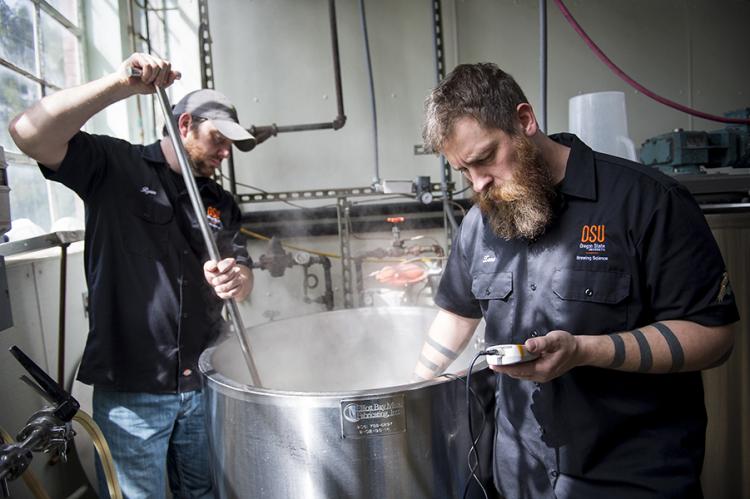
Research students in Oregon State University’s fermentation science program work on a brew of malted barley. Jason Zeno (right) monitors the slurry’s temperature as Ryan Howe (left) stirs the pot.
CREDIT: OREGON STATE UNIVERSITY
They seek a deeper understanding of the ingredients that go into various types of beers. With powerful technology, they are teasing apart the biological quirks of standard beer ingredients such as hops and yeast, and scrutinizing microbial communities that are responsible for more exotic brews. And they are turning up surprises, such as unsuspected bacteria lurking in burbling barrels of beer.
These modern discoveries will help brewers drive the fermentation process in more precise ways. Already, based on new knowledge, they are concocting more consistent and creative types of beer. “We’ve come a long way, and beer is better than it’s ever been,” says geneticist Kevin Verstrepen of KU Leuven in Belgium.
Capabilities will only improve in the future, he adds, aided by both science and art.
The brewhouse laboratory
If a blindfolded person were guided into a modern brewery and then unmasked, they might guess they were standing in a biotechnology company. Many of today’s breweries are brimming with scientific sophistication, packed with stainless steel tubs, racks of pipettes and expensive equipment with blinking lights. That’s certainly true of the brewery at UC Davis, where Bamforth and his students experiment.
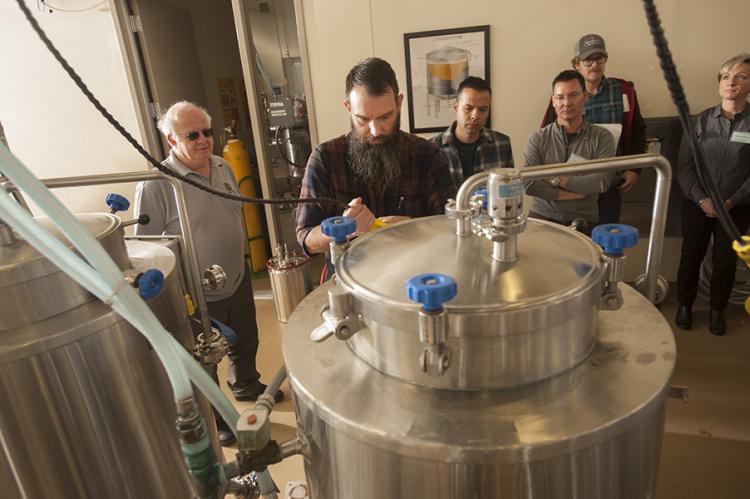
Researcher Joseph Williams moves beer into a tank during a UC Davis brewing class in 2016.
CREDIT: UC DAVIS
As he walks around shiny kettles and a line of toy-sized fermentation vessels (designed to enable small-scale tinkering), Bamforth describes the journey from water to beer. In a mill room off to the side of the brewery, dried malt gets crushed into a flour. That goes into water, forming a mash with the consistency of porridge. In a big bin called the lauter tun (from the German word abläutern, “to clarify or purify”), the solid material is separated and sent off to feed cows, while the sugary liquid, or wort, goes on to the brew kettle. That’s where hops are added for bitterness and other flavors.
From there, the hot, sweet wort gets filtered, cooled and piped into the fermenter, where the yeast bring the magic, furiously multiplying as they convert sugars into alcohol and carbon dioxide. The alcoholic brew is then sometimes aged — Budweiser, for instance, rests in tanks for three weeks.
“Fermenting a sweet, bitter soup into a beer is a very complex thing,” says biotechnologist Troels Prahl of White Labs in Copenhagen, a company that supplies yeast strains to brewers. The broad strokes of that process were illuminated years ago, partly by researchers at large, brewery-based labs. (Some fundamental scientific tools originated in breweries, too: Scientists at the Carlsberg brewery in Copenhagen developed the pH scale in 1909, and the statistical staple known as the student’s t-test was devised by a brewer at Guinness around the same time.)
At its heart, brewing is chemistry, enzymes and microorganisms, and beer science at breweries was once a positive bustle. When Bamforth joined the Bass brewery in beer-loving Britain as a research manager in the 1980s, he led a team of 30 ambitious scientists — fundamental chemists, molecular biologists and biochemists. Other breweries, including Guinness in Ireland and Foster’s in Australia, housed large research teams, too. “There were meetings all over the place, and people would be racing to be the first to present the science of malting and brewing,” Bamforth recalls.
Many of those robust programs are now gone, and most of the big questions about brewing have been answered. These days, people can easily access the tools and knowledge needed to make good beer.
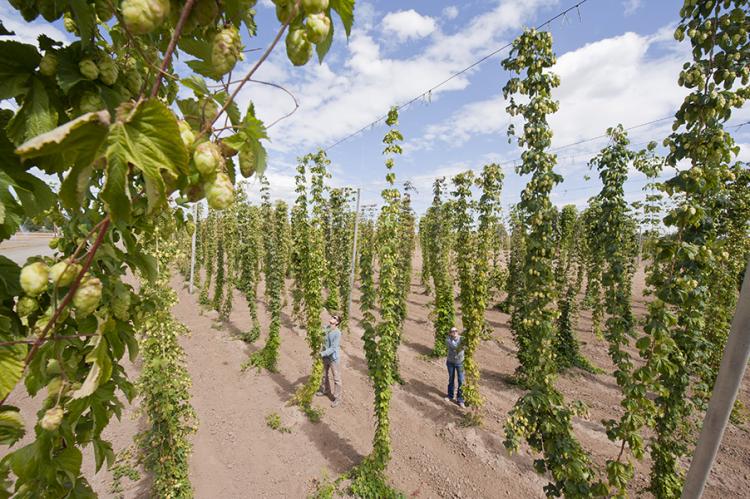
Hops ready for harvest in the Oregon State University research hop yard.
CREDIT: OREGON STATE UNIVERSITY
But for all that early research, there are still large swaths of unmapped territory, says hops chemist Tom Shellhammer of Oregon State University in Corvallis, who delights in finding and filling these knowledge gaps. “It’s like, ‘Wow, this is an open spot on a plot of land that people have been walking around on for 5,000 years.’”
An open spot staked out by Shellhammer and colleagues concerns the aromatic molecules found in the oil extracted from heady, pungent hops — the assumed source of most of beer’s taste. (The tangled relationship between people’s noses and mouths means that much of beer’s “taste” actually stems from its smell.) For all of today’s growing interest in aggressively hopped beers such as double IPAs, brewers still don’t know all of the components in hops oil that create the flavor. “We’re trying to answer a real, common-sense, conventional-wisdom question,” Shellhammer says. And, he adds, the answers may surprise some brewers.
Many brewers logically assumed that the more hops oil added to the beer, the stronger the aroma would be. But Shellhammer and his team are finding that hops oil can vary wildly in aromatic concentration — some varieties of plants produce potent oil, with just a little bit needed for a big flavor, and others produce weaker versions. He pulls up a chart on his computer screen that displays about 20 aromatic ingredients in various hops oils — just a taste of the full catalog, which numbers in the hundreds. So which are the crucial chemicals that brewers should care about? Scientists are combing through them all to track down the important aromatic players.

Scientists are trying to understand the range of flavors that hops can lend to beer. So far, researchers have cataloged hundreds of aromatic ingredients that come from various hops oils.
CREDIT: OREGON STATE UNIVERSITY
Such nuances may not have mattered in the past, but today they are key. A decade ago, really hoppy beers didn’t exist. But now, “there are double IPAs that are so loaded with hops that they’re almost like hop teas,” Shellhammer says. Work like his should ultimately allow brewers to select precise amounts of precise varieties of hops to create beer that tastes just the way they want it to.
Yeasty wee beasties
Other knowledge gaps exist around the microbes that do the fermenting. Beer, of course, was brewed long before brewers knew what yeast was. (Medieval brewers called the mysterious substance “godisgoode.”) In the 1800s, Louis Pasteur identified yeast and also described a fermenter that could prevent other microorganisms from spoiling the beer. Other advances quickly followed, and the basic biochemistry of fermentation was soon worked out.
But brewers’ understanding of yeast is still incomplete. Today, many keep to their own special yeast strain or two and consider them sacrosanct, key to churning out a consistent and delicious brew. Yet a prized strain may still be quite mysterious, with hazy origins (given by a friend, or even illicitly purloined at some point in the past) and poorly understood genetics and physiology. “It might make the beer they want to make, but it’s not always the best yeast,” Verstrepen says.
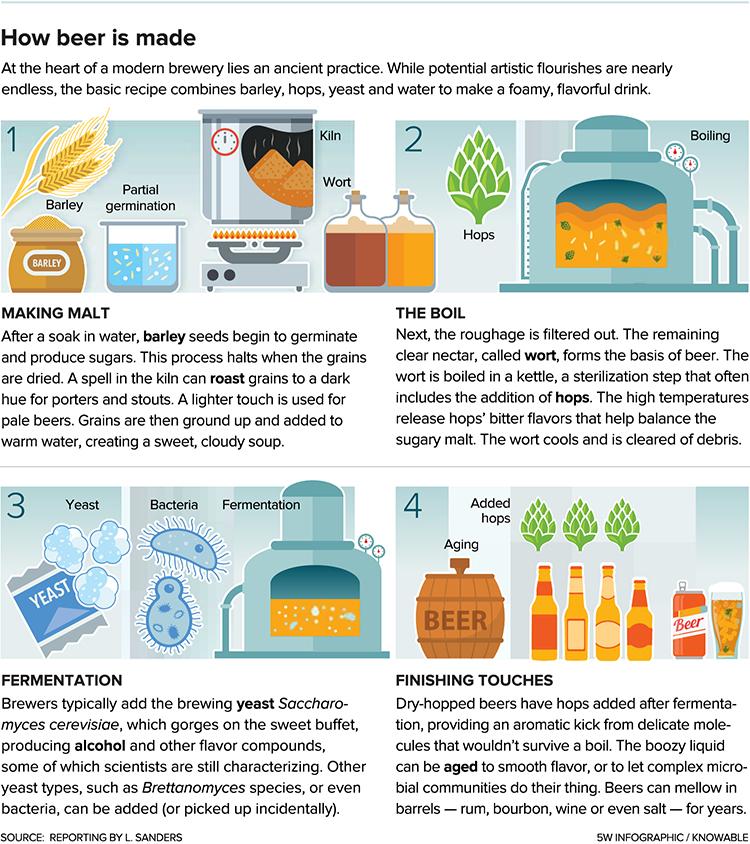
To bring some knowledge and order to the scene, Verstrepen, Prahl and collaborators scrutinized the genomes and behavior of 157 distinct strains of Saccharomyces cerevisiae, the yeast used in brewing and baking. “We’re cataloging what’s out there,” Verstrepen says. Most of these strains were brewing yeasts, but the samples included a handful of yeasts that make wine, spirits, bioethanol fuel and bread, as well as a few strains scientists use in labs for basic research.
The detailed genetic catalog, published in 2016 in Cell, describes the wild early days and eventual taming of many of the strains, as well as their beer-making abilities. It’s a guidebook for adventurous brewers, one that might ultimately point to superior yeast strains that can brew more efficiently, or imbue the beer with different flavors.
The DNA of flavor
With such data, and with cheap and thorough genome-sequencing tools in hand, scientists can start linking particular genetic attributes of yeast to flavors — because hops don’t tell the whole story. Explaining a taste in biochemical terms is tricky, says molecular cell biologist Johan Thevelein of KU Leuven. Flavor molecules can be influenced by many genes, and in many cases there’s no easy way to predict what kinds of flavors a yeast strain will make without actually fermenting with it.
That’s what led Thevelein and colleagues to conduct a giant experiment in which they created thousands of genetically different S. cerevisiae strains through breeding. Then they set up thousands of tiny fermentations for each offspring, each one enough to yield about two shot glasses’ worth of beer. The search was for yeast strains that produced lots of the rose- or honey-flavored chemical phenylethyl acetate, and then to pinpoint the responsible parts of the yeast genome. After combing through the results, the researchers found DNA sequences at two spots in the genome that could each cause a big uptick of rose flavor.
The initial discovery was made with brute force. But a slick new genome-editing tool called CRISPR/Cas9 allowed the researchers to recreate those same flavor-linked DNA sequences and thus prove that the two regions truly were behind the sweet rose characteristic. The same tool could enable scientists to create rosier flavors in whatever yeast strain they chose.
Advances like CRISPR editing hold great potential, says Verstrepen. His research group does a lot of old-fashioned yeast breeding, but he’s also got genetically modified yeast sitting in his lab freezer. “With breeding, we can go to 50 percent more fruity,” he says. “But with genetic engineering, you can go tenfold or more.”
Buckets of something better
Sophisticated genome techniques also allow scientists to take a census of the microbial fermenters that nature has already provided, including ones that may have escaped brewers’ notice. Geneticist Maitreya Dunham of the University of Washington and colleagues wanted to see if a method they’d developed, called Hi-C sequencing, could help parse the still somewhat mysterious ecosystem of a barrel of beer. (Dunham has a financial stake in a biotech company based on the method, which allows one to distinguish the genetic material of closely related species.)
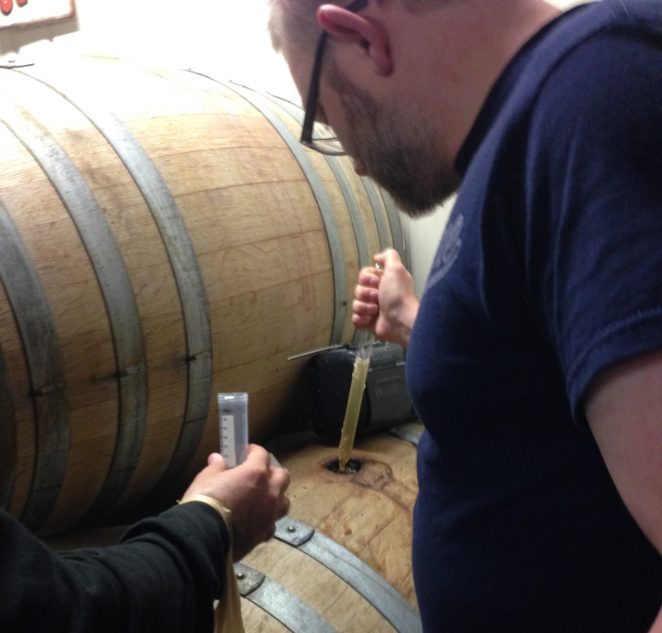
Brewer Cody Morris and UW Seattle scientist Ivan Liachko draw a sample of “Old Warehouse” brew to bring back to the lab for testing.
[An earlier caption misidentified the hand in the photo and the photographer. It has been corrected.]CREDIT: MAITREYA DUNHAM
So the scientists left their gleaming genetics lab in the heart of Seattle and ventured south, to a dusty warehouse. An eclectic brewer named Cody Morris had been tinkering there with wild beers — brews that start in open buckets and get fermented by whatever microbes happen by. The basement had a dirt floor, Dunham recalls. “There was junk all over the place, cobwebs.” Morris had let nature take its course in buckets of sugary wort that were scattered around the space. One of Morris’s favorite buckets, a beer he sold as “Old Warehouse,” had just been topped off with fresh wort and was full of action, brimming with bubbles. The team took a sample and headed back to the lab.
Their analyses, which appeared online October 19 in the journal Yeast, identified four different yeast species, including one particularly exotic specimen: a hybrid brand new to scientists. One of its parents seems to be a species called Pichia membranifaciens, an under-studied yeast that may protect grapes from a fungal disease but also rots strawberries and other foods. The other parent is unknown. News of Dunham’s discovery spread, and experimental brewers have been requesting the yeast, which the researchers informally call Pichia apotheca, for “warehouse.”
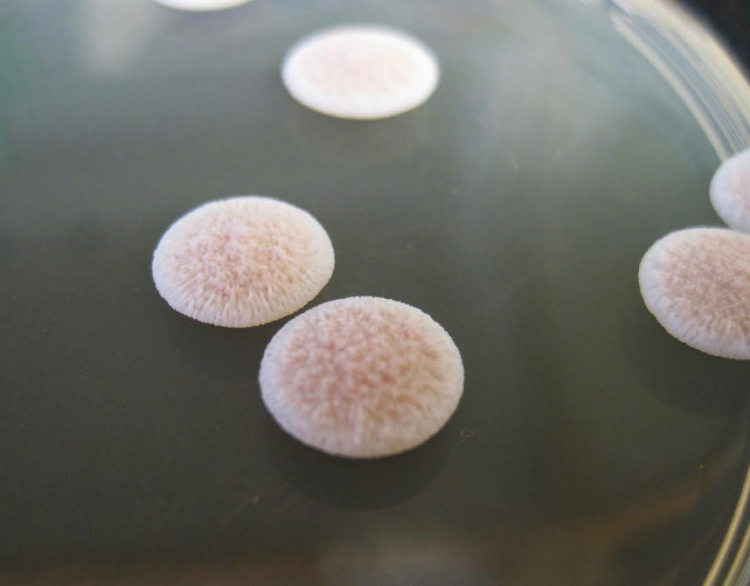
Lab-grown colonies of Pichia apotheca, a hybrid strain of yeast discovered in a beer sample from a brew dubbed “Old Warehouse.”
CREDIT: IVAN LIACHKO
“When we tried to make beer with the Pichia hybrid, it didn’t do so well,” Dunham says. The 60 or so brewers who now have it in hand may fare better. “They are so eager to try out new things, and to understand the microbes and what they’re doing.” Some of them have invited Dunham to come taste the Pichia beer at their next home-brewer’s meeting.
Waiter, there’s bacteria in my beer!
Pichia may be garnering the limelight, but scientists are encountering other microbial surprises. Dunham and colleagues also turned up four types of bacteria in Morris’s bucket, two of which, again, were previously unknown. These bacteria may have a hand in brewing, contributing to the sour flavor of some beers.
And the barrel that the Old Warehouse brew was stored in might also have contributed influential microbes. As brewers experiment with aging beers in barrels that once held whiskey, rum, wine, maple syrup or even salt — hoping to tint their beer with novel flavors — they may be getting more than that. “These barrels aren’t coming in sterile,” says microbiologist Christopher Curtin of Oregon State University in Corvallis. “You’ve got these yeast and bacteria that have their own ideas of what they can do to shape the flavor, and we’re not at all clear on how important that is.”
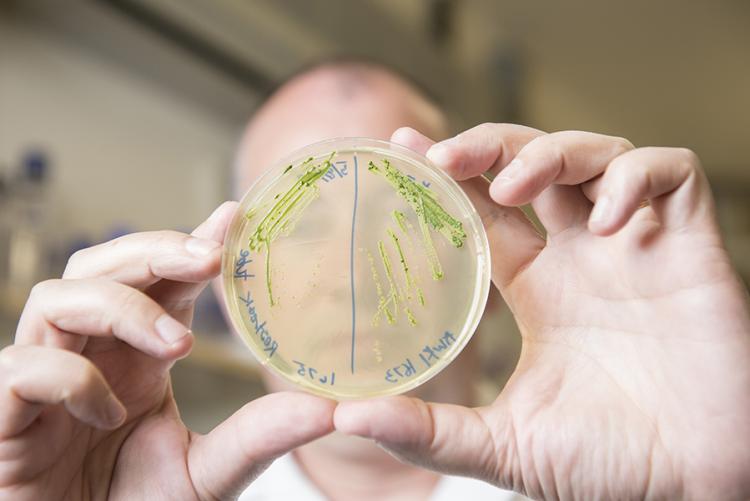
Just like us, beers have microbiomes — and they affect the brewing process. Scientists like Christopher Curtin are trying to understand the microbes — many still undiscovered — that give barrel-aged beers their ultimate flavors.
CREDIT: OREGON STATE UNIVERSITY
To get at the question, Curtin and his team have begun a project to follow the microbial populations — what are called the microbiomes — of barrel-aged beers at a brewery, as they evolve over months and years. As more and more brewers embrace this sort of random inoculation, it will be more important to understand how it works, he says. “The next phase would be how to push the microbiome in the direction you want it to go” — perhaps arriving at a clean beer with a hint of sour, say, by adding a dash more Lactobacillus and a smidge less Brettanomyces yeast.
It's all still good old beer
With a deeper knowledge of the microbes that make beer, and the molecules that impart flavor, brewers and scientists will gain more control over the process. And brewers, particularly those in the United States, are getting more playful. They’re pushing alcohol and hops to levels never before seen in beers. They’re spiking their brews with rum-barrel residue, brewing inside of tree trunks and even adding roasted, sliced bull testicles to stouts to create an earthy, pungent mouthfeel. “Even 10 years ago, we hadn’t seen beers like this,” Shellhammer says.

Volunteers characterize the aroma and flavors of beers made with hops at Oregon State University. Careful selection of hops can give rise to the bitter hints of an IPA or citrus notes to ales.
CREDIT: OREGON STATE UNIVERSITY
Some of these improvisations are enabled by hard science — genetics, microbe studies and more. But brewing researchers stress that despite all the new tools and insights, beer will never fully escape its rich history and tradition. A beer will remain a beer, a beverage to be judged by the drinker, to savor and enjoy.
Nowhere is this more apparent than in the laboratory brewery at Oregon State. Sunlight streams into the cavernous experimental space on an unusually sunny October day, lighting the seven golden brews on trays in front of a group of tasters. The mood is relaxed. Soul music plays from a boom box as Shellhammer and his students gather around a metal table. It’s the end of a brew run, and these brewers are using their noses, mouths and eyes to judge their latest brewing experiment.
Each beer has been made with a different level of hops, and some had an extra enzyme added. The tasters smell, swirl and sip, using their senses to gauge the brew, occasionally murmuring words like “garlicky” or “cooked fruit.” Their deep attention to the science and craft is obvious, but so is their enjoyment.
Back in Davis, Bamforth talks about beer’s history as a social glue, and how that won’t change, no matter what advances brewing scientists make. Then he describes a bare-bones pub in the industrial northwest of England where he’s passed more than one evening, an establishment that’s stayed the same for generations.
There is no TV, no music and no fancy menu. “Just people sitting there talking to one another, drinking beer.”




